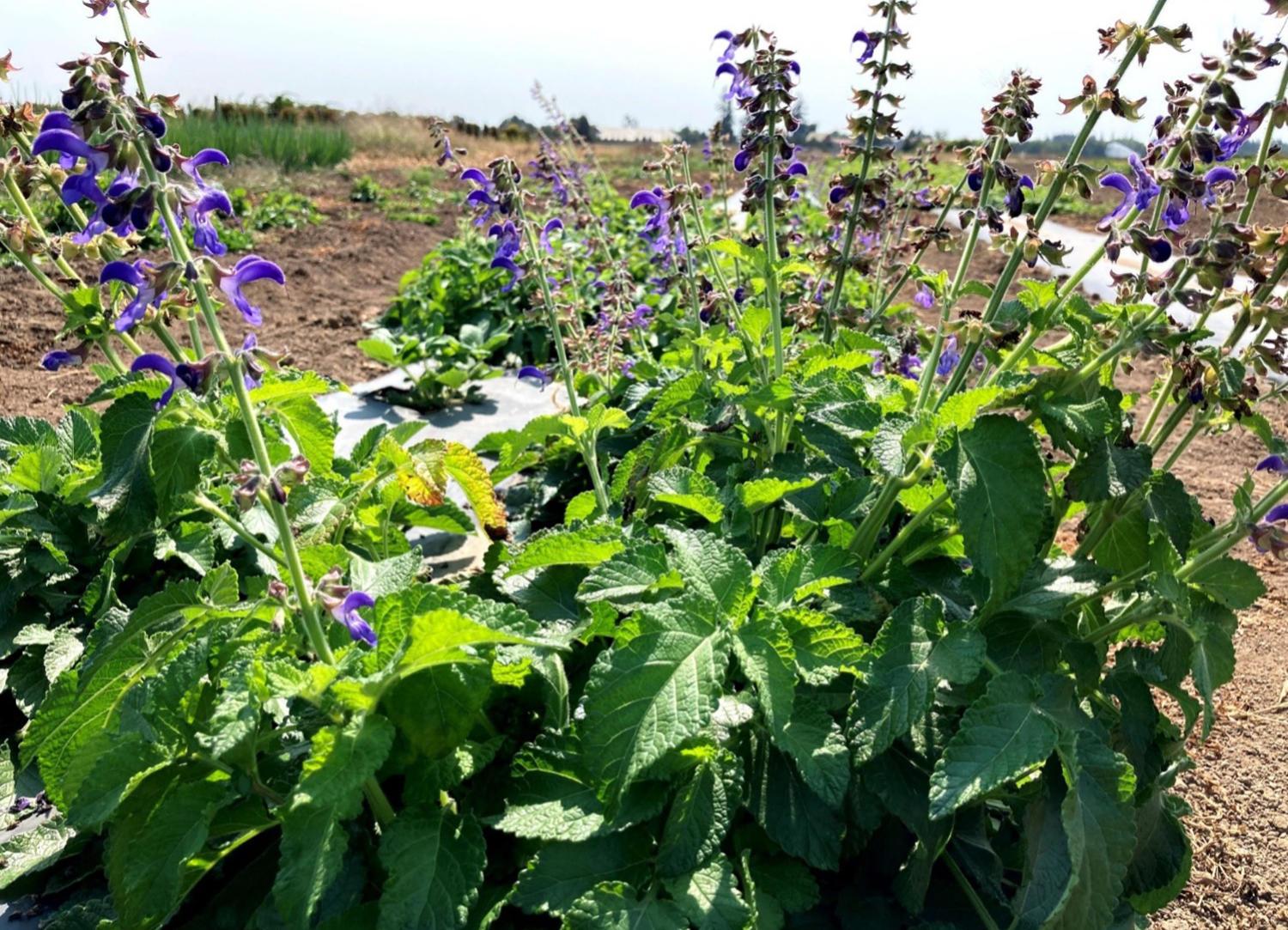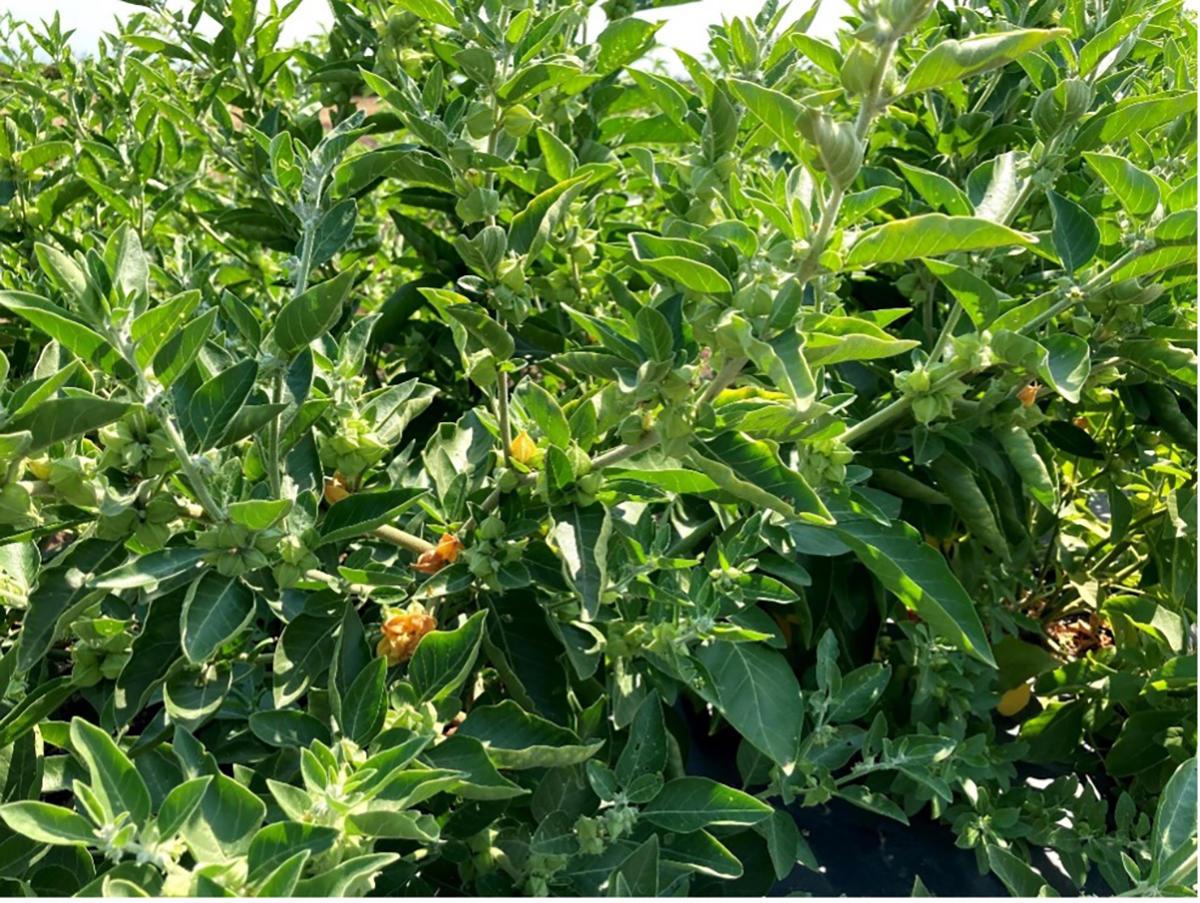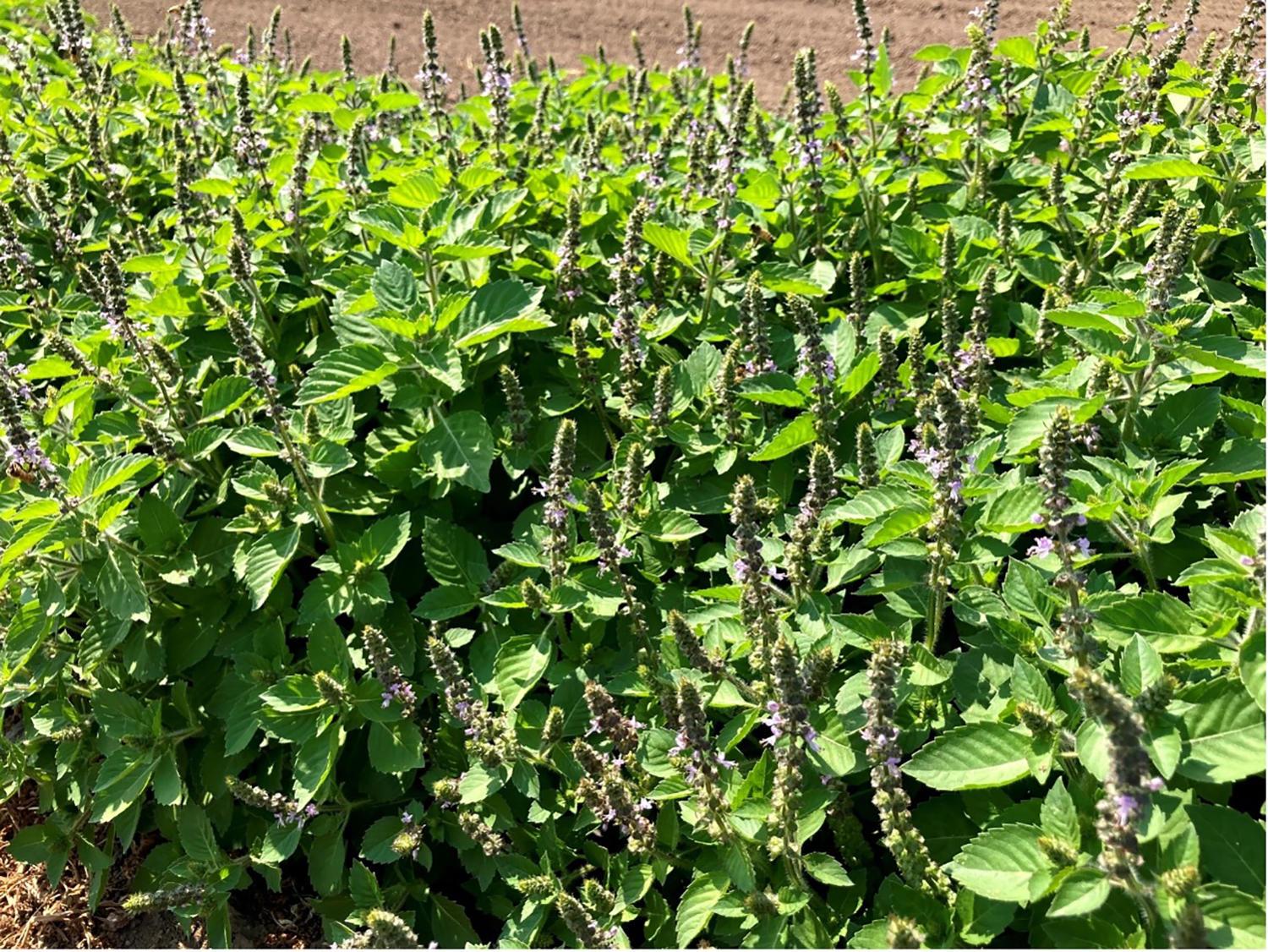Overview
Medicinal herb crops are a diverse group consisting of both annual and perennial species. Some herbs are harvested for their flower or leaf tissue; others are harvested for root tissue or fruit. Within the herb production industry, there are opportunities to identify crops that may fit well in the cropping systems of the Pacific Northwest.
More specifically, vegetable producers may be well-positioned to produce new crops that could provide diversity on farms and profitable yields. In order to support producers interested in adopting new herb crops with training and resources, our group sought to identify what crop species are suited to our production areas, what opportunities exist in current and future markets, and what obstacles exist that may be addressed with either research or Extension projects.
The authors cooperated with regional farmers currently producing herb crops to identify potential crop options for new adopting farms. We made selections based on growing conditions, availability of seeds or transplants that have been appropriately vetted, potential market opportunities and ease of production for adopting growers.
Table 1 reports the top 30 species that may be suitable matches for production in the region. Crops were grouped into categories based on the perceived potential for widescale production.
In addition to this work on crop identification, Ben Marx from Oregon College of Oriental Medicine designed and administered a survey of acupuncturists and Chinese medicine providers across the U.S. to quantify the current herb use patterns and industry preferences on sourcing herb products.
Both the crop identification and practitioner survey results were shared at a national industry conference held virtually in March 2021 and other professional conferences. We gathered farmers, herbalists, processors and practitioners highly experienced in the current industry to review our preliminary work. Participants helped provide direction for future research and Extension work. A summary of the conference proceedings follows.
Current industry
Herb use, in general, across the U.S. has increased dramatically in recent years. In 2016, China exported $526 million worth of traditional Asian medicinal products to the U.S., according to estimates. About 40.6 million adults — 1 in 5 — consumed herbs or supplements in the U.S., according to the 2012 National Health Interview Survey.
Since then, herb use has skyrocketed due to health concerns related to the COVID-19 pandemic. Herbal supplement sales now total an estimated $11.261 billion within the U.S.
Major health concerns during the pandemic included stress and mental health, which were reported as main factors in driving increased sales of herbs such as Ashwagandha. Reported sales for this herb increased by 185% in 2020.
Currently, there are great opportunities to sell raw unprocessed herbs, either fresh or dried. In recent years, bulk herb sales have grown because practitioners recognize an increased efficacy of herbs that have not been stored for long periods and are minimally processed.
Processing also takes extra investment by the farm, complicating the steps to market and potentially reducing profit.
Processing into granules requires a manufacturing facility with FDA approval. It is estimated that at least 500kg — 600kg of bulk herbs in one lot are needed to reach scale requirements in granule production.
It would be difficult for many farms to produce this amount at a profit without sufficient crop contracts to reduce risk to the growers.
Due to all these current conditions, the most significant potential may be for locally produced, bulk herbs that can be marketed as fresher than imports.
Potential crops for the Pacific Northwest
We conducted interviews and farm visits with experienced herb producers throughout the western U.S. in late 2020 and early 2021. We also conducted an online survey with an additional 10 growers to collect information on current herb production crops and research and education needs. Through the experiences of regional growers, we developed a list of potential crops suited for both the regional growing conditions within the Pacific Northwest as well as crops that may have the potential to fill a need within the market.
The list below shows the top 30 crops. Possible crops are grouped by their growth potential on the field conditions needed, ease of adoptability, production/harvest, and estimated market demand. For example, Carthamus tinctorius, or safflower, might be a good fit for field conditions in the Willamette Valley. However, the flowers are the marketable portions that are sharp, difficult to handle, and challenging to get good quality with a machine harvest. This crop was given a "Below Average Potential" rating due to difficult harvest considerations. Similar inputs with other crops helped determine the potential rating.
| Latin name | Common name | Pinyin name | Overall potential |
|---|---|---|---|
| Astragalus membranaceus | Astragalus | huáng qí |
High potential |
| Codonopsis pilosula | Poor man’s ginseng | dǎng shēn |
High potential |
| Scutellaria baicalensis | Baikal skullcap | huáng qín |
High potential |
| Withania somnifera | Ashwagandha | * |
High potential |
| Ocimum spp. | Sacred basil/tulsi | * |
High potential |
| Salvia miltiorrhiza | Red sage | dān shēn |
High potential |
| Rosa rugosa | Mei Gui Hua |
High potential | |
| Gentiana scabra | lóng dǎn cǎo |
High potential | |
| Plantago asiatica | Plantain | chē qián zĭ |
Average potential |
| Prunella vulgaris | Heal all | xià kū cǎo |
Average potential |
| Angelica dahurica | bái zhĭ |
Average potential | |
| Arctium lappa | Burdock | niú bang zĭ |
Average potential |
| Chrysanthemum morifolium | Mum | jú huā |
Average potential |
| Carthamus tinctorius | Safflower | hóng huā |
Average potential |
| Centella asiatica | Gotu kolu | jī xuě cao |
Average potential |
| Platycodon grandiflorus | Balloon flower | jié gěng |
Average potential |
| Schisandra chinensis | Five flavored fruit | wŭ wèi zĭ |
Average potential |
| Polygonatum sibiricum | huáng jīng |
Average potential | |
| Paeonia lactiflora | White peony | bái sháo / chì sháo |
Average potential |
| Cornus officinalis | Dogwood | shān zhū yú |
Average potential |
| Atractylodes koreana | cang zhū |
Average potential | |
| Ophiopogon japonicus | Lilyturf | mài mén dōng |
Average potential |
| Panax quinquefolius | American ginseng | xī yáng shēn |
Below average potential |
| Nepeta tenuifolia | jīng jiè |
Below average potential | |
| Angelica acutiloba | dang gui |
Below average potential | |
| Eclipta prostrata | Eclipta | mò hàn lián |
Below average potential |
| Trichosanthes kirilowii | Chinese cucumber | guā lóu/tiān huā fěn |
Below average potential |
| Forsythia suspensa | lián qiào |
Below average potential | |
| Dioscorea opposita | Chinese yam | shān yào |
Low potential |
| Bacopa monnieri | Brahmi | * |
Low potential |
*Traditional Ayurvedic medicines
Practitioner survey
In a similar manner as with identifying potential crops, we also interviewed practitioners and herb suppliers about current herb purchasing trends in late 2020 and early 2021.
An electronic survey with 69 respondents across the U.S. assessed the current demand and industry standards around sourcing and prescribing herbs.
Respondents were mostly acupuncturists and Chinese medicine providers. Eighty-nine percent of survey respondents said if Chinese herbs were grown in the U.S., they would be interested in prescribing them to their patients instead of imported herbs.
Results show that 58% of patients are prescribed herbs in a given week. In practice, acupuncturists are commonly prescribing 96 different herbs.
Perhaps more critically, when asked to rank order the criteria that providers use to assess the quality of herbs, they describe contamination (heavy metal or pesticide) as the top concern.
The least important factor in determining quality was the location grown. By this measure, it seems as though locally grown herbs could potentially provide exclusion of contaminants that would be suitable for providers.
When we compare the top prescribed herbs as reported on the provider survey and the list of grower-selected potential crops (Table 1), we come up with the following crops that are on both lists:
- Paeonia lactiflora (practitioner No.1)
- Angelica acutiloba (practitioner No.2)
- Astragalus membranaceus (practitioner No.4)
- Scutellaria baicalensis (practitioner No.7)
The convergence of the two lists may be an important place to start for research and growers adopting new crops.
Herb quality
Herb quality is a top concern for both practitioners and growers. Practitioners need to know the herbs are effective and meet the expectations of the patients.
Practitioners look for quality herbs that are sustainably sourced, organic and highly effective. Practitioners also look at the safety of herbs with no contaminants and the correct species of plant harvested/processed to maintain quality.
At the same time, many practitioners have not had formal training in performing quality assessments and therefore rely heavily upon their herb suppliers for maintaining these quality standards. Improved methods or guidelines to assess quality for specific herbs on the market could prove helpful for both medical practitioners and growers.
Growers want to deliver high-quality products to the market that meet or exceed the quality standards. Yet growers often wonder what specific traits or indicators are for each crop and how best to evaluate the crop for these quality markers.
Herb buyers currently do not always look for specific test results to indicate constituent levels, depending on the market. Instead, buyers often are looking for ‘vital qi’ (pronounced CHĒ) in the product (potency, or vital energy); macroscopic quality is important — smell, look, freshness. Is the herb bright? Does it smell fresh?
This approach to evaluating quality is often referred to as organoleptic evaluation — using the senses to assess the overall quality of the product — and is often the primary means of assessing herb medicinal quality by the traditional Chinese medicine industry.
Organoleptic evaluation skills take years to develop. Not many individuals within the U.S. have had adequate training on a wide variety of crop species to be considered reliable experts, further complicating the quality assessment debate.
Some markets, such as the nutraceuticals industry, often use chemical testing methods such as high-performance liquid chromatography to identify key chemical constituents.
The Chinese Pharmacopeia is one of the most consistently used sources to help identify the specific components that should be present at specific levels for herbs to be sold as medicinal herbs in China.
Without translation services available, growers and the herb industry within the U.S. lack access to this information.
Currently, the American Herbal Pharmacopoeia only contains a small fraction of medicinal herbs grown and sold in the U.S.
Future research to inform the completion of additional herb profiles would benefit the herb industry.
Future research
There are numerous research questions for herb crops, some specific to individual species and some questions that apply to the industry, such as how to assess quality. In deciding where to start future research efforts, attendees offered several different approaches.
Some approaches to deciding which crops to prioritize for research in the U.S. might include:
- Herbs that often have high pesticide or other contaminant residues (such as metals).
- Herbs that lose efficacy when not fresh or that have a short shelf–life.
- Plants that produce more than one herb (such as plants grown for fruit, fruit peel, root or seed).
- Crops that grow better in the region (Pacific Northwest or western Oregon) than anywhere else.
- Crops that best fit specific grower types in the region (large-scale mechanized production with drying capacity or small-scale, labor-intensive production).
- Rare or expensive herbs (may be more labor-intensive) that would be a potential crop for small-scale growers.
Another suggestion for prioritizing research needs is to focus on the process of adopting a new crop. We could pick five crops with demand in the marketplace that are also good model crops for finding solutions to the various barriers. Limited formal market assessments are currently available for most medicinal herb crops. However, informal demand and prices can be found through discussions with buyers and at online bulk herb retailers.
For example, a case study of Salvia miltiorrhiza, a short-term perennial root crop, could describe experienced grower crop production, harvest and processing and drying practices. It would also summarize the research literature and translated text from the country of origin on production and processing techniques. The case study research could culminate in publishing an in-depth production manual suitable for reference by growers and those first adopting the crop in production systems.
Another research approach lends toward great interdisciplinary work between traditional Chinese medicine providers and growers. This approach would involve an integrated farm and practitioner connection where specific crops were grown for clinical needs identified by practitioners or clinical groups that could then assess the efficacy of the locally grown herb within the medical community. Cooperation between farmers and traditional Chinese medicine practitioners an interesting topic. It can help build relationships and direct markets, but the focus should remain on ensuring adherence to observable quality assessment traits (lab testing, organoleptic or a combination of both). In the Pacific Northwest, we are uniquely suited to this type of collaboration due to our capacity to grow desirable herbs. We also have regional schools for traditional Chinese medicine degrees.
Conclusion
Production of medicinal herb crops within the Pacific Northwest promises to fill market demands for high-quality herbs. Work to assess the regional market demand is currently in progress. Conference attendees identified top crops for the region as well as methods to approach future work to meet the research and education needs of the industry.
Acknowledgments
This project was funded by NIFA Organic Research and Extension Initiative. We wish to thank our grower and practitioner cooperators and conference attendees for sharing their time and expertise.
References
Buckland, K., B. Marx, P. Schafer, N. Andrews, A.G. Stone and A. Rasmussen. 2021. Assessing the Needs of Organic Medicinal Herb Production in the Pacific Northwest. Abstracts of Presentations from American Society of Horticultural Science 2021 Annual Conference, HortScience, 56(9S), S1-S273. Retrieved Jan 31, 2022.
Lin, A.X., G. Chan, Y. Hu, D. Ouyang, C.O.L. Shi and H. Hu, 2018. Internationalization of Traditional Chinese Medicine: Current International Market, Internationalization Challenges and Prospective Suggestions. Chinese Medicine, 13(1), p.9.
Schafer, Peg. The Chinese Medicinal Herb Farm: A Cultivator's Guide to Small-scale Organic Herb Production. Chelsea Green Publishing, 2011.
Smith T., F. Majid, V. Eckl, C. Morton Reynolds. Herbal supplement sales in U.S. increase by record-breaking 17.3% in 2020. Herbal Gram. 2021;131:52-65.
Wu C., C. Wang, M. Tsai, W. Huang and J. Kennedy. 2014. Trend and Pattern of Herb and Supplement Use in the United States: Results from 2002, 2007, and 2012 National Health Interview Surveys, vol. 2014





